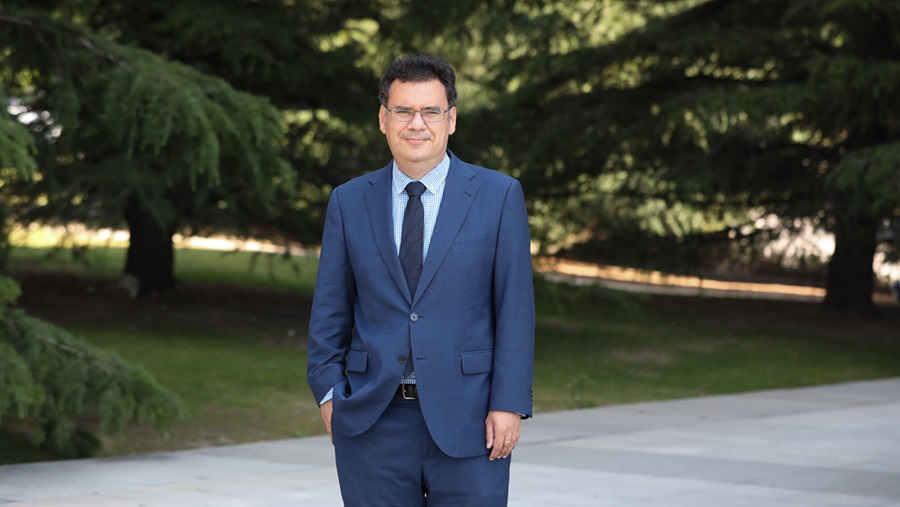- Research
- 12 de February de 2025
- No Comment
- 10 minutes read
Ismael Sanz: “What enhances productivity growth is learning”

Interview with Ismael Sanz Labrador, professor of Applied Economics at the Rey Juan Carlos University (URJC).
Ismael Sanz: “What enhances productivity growth is learning”


Eva Serra
Those active on social media, particularly on X, and interested in educational evidence, will likely be familiar with Professor Ismael Sanz (@sanz_ismael). A dedicated researcher, he has consistently provided us with rigorous data, reports, and studies from reputable academic sources and research journals.
Ismael Sanz holds a PhD in Applied Economics from the Complutense University of Madrid (UCM) and was awarded the Extraordinary Doctoral Thesis Prize in 2007 by the Faculty of Economic and Business Administration. He is currently an Associate Professor in the Department of Applied Economics I at Rey Juan Carlos University. Additionally, he is a Visiting Senior Fellow at the London School of Economics (LSE) and a member of the Women in Social and Public Policy Research Hub (WISPPRH) at LSE.
Previously, he served as Director General of Innovation, Scholarships, and Grants at the Department of Education of the Community of Madrid (2015–2019), Director of the National Institute for Educational Evaluation (INEE) at the Ministry of Education, Culture, and Sport (2012–2015), and Chair of the Strategic Development Group of PISA at the OECD (2014–2015). He has undertaken advanced study courses and research stays at institutions such as the University of California, Santa Barbara; Victoria University of Wellington (New Zealand); the New Zealand Treasury Department; the University of Otago (Dunedin, New Zealand); Australian National University; the Kennedy School of Government (Harvard); and the University of Nottingham.
He is the author of articles published in international research journals such as Economic Journal, Oxford Bulletin of Economics and Statistics, Scandinavian Journal of Economics, Canadian Journal of Economics, European Journal of Political Economy, Public Choice, and IZA Journal of Labour Studies.
Your X account is consistently active with studies and data. Recently, you posted: “People who withhold information ultimately develop less creative ideas”. To what extent do you believe sharing information is essential?
Social media provides a valuable space for discussions on education, but not all opinions are rooted in empirical data and analysis. My aim on X is to present findings from rigorous research on how to enhance student learning, improve educational outcomes, and support the well-being of both teachers and students.
Does the rise of misinformation make it more difficult to distinguish fact from falsehood, or do we have effective ways to filter reliable information?
Many of the studies I share establish causal relationships—examining educational strategies that have demonstrably worked and produced measurable effects. These studies are published in highly selective academic journals, most of which accept only 5% of submitted articles—just one in twenty. This stringent peer-review process ensures that the findings reflect genuine causal effects, where one factor directly influences another. Such selectivity acts as a benchmark for quality and reliability.
“A study published in American Economic Journal demonstrates that when a Black primary school student in the U.S. has a teacher of the same race, their academic performance improves—not only in that academic year but in subsequent years as well”
Which recent educational study have you found particularly compelling?
Although it was not among the most widely shared posts on X, a study in the American Economic Journal found that Black primary school students in the U.S. who were taught by a teacher of the same racial background performed better, not only during that school year but in subsequent years as well. Specifically, they were six percentage points more likely to complete high school (equivalent to sixth form in the U.K.) and pursue higher education. Having a teacher from a similar racial or social background can serve as a powerful source of motivation, reinforcing the belief that “you can achieve this too”. This highlights the importance of a diverse teaching workforce, ensuring that students from all backgrounds have role models who inspire them to succeed.Final del formulari
In Catalonia, key information about schools—such as Selectividad (University Entrance Exam) rankings—is not published. In your view, is this a mistake?
I see this as a positive approach. Schools in disadvantaged areas could face unintended consequences if EVAU (university entrance exam) results were publicly available, as their performance may, on average, be lower. This could prompt high-achieving students to transfer elsewhere, exacerbating existing inequalities. If rankings were to be published, they should be adjusted to reflect value-added measures—showing how schools perform relative to expectations based on their students’ socio-economic backgrounds. Another alternative would be to report changes in performance over time rather than just overall scores, ensuring that schools making significant improvements receive due recognition.
What is the link between education and the economy?
In economic research, human capital and its impact on economic growth and productivity were traditionally measured by years of schooling. However, educational quality varies significantly across countries, meaning that the same number of years in school does not necessarily produce equivalent learning outcomes. Since the introduction of PISA in 2000, along with PIRLS and TIMSS, we have gained a deeper understanding of learning quality. These assessments allow us to consider two key sources of information: years of schooling and the effectiveness of education. Research suggests that the latter is more decisive. What truly drives productivity growth is not simply time spent in education but the acquisition of knowledge and skills learning quality.
“Recent research suggests that if public spending is efficient and well-targeted, educational outcomes can improve. One example is class size reduction”
What is the relationship between educational investment and academic outcomes?
Traditionally, research indicated no clear correlation between public spending and student achievement. The prevailing conclusion was that education funding is effective only up to a certain threshold—beyond which additional investment does not necessarily translate into better outcomes. However, more recent studies suggest that if spending is allocated efficiently and strategically, it can lead to significant improvements.
One key example is class size reduction. Lowering the student-to-teacher ratio is expensive and requires substantial investment, making it impractical to implement universally without affecting other areas of the education budget. However, research has shown that in primary education and schools with a medium-to-low academic profile—particularly those with poor performance or high levels of disruptive behaviour—the impact can be considerable. In these contexts, reducing class sizes can be a highly effective strategy for improving student outcomes.
What do you make of criticisms regarding the decline in academic performance reflected in international assessments such as PISA, TIMSS, and PIRLS?
These reports generally show a decline in the competencies of 15-year-olds (PISA) and 9–10-year-olds (TIMSS and PIRLS) compared to 25 years ago. Having access to this data is crucial—it prevents us from assuming that education is improving when, in reality, it may not be. Not all educational innovations are beneficial; some yield positive results, while others do not, making it crucial to measure outcomes objectively.
The 2025 results suggest a decline in proficiency in mathematics, reading, and science compared to 2000, when PISA was introduced. This may be due to a shift in educational priorities, with increased emphasis on other competencies at the expense of traditional subjects. However, this trend is not unique to Spain—it is observed internationally. While students today may demonstrate slightly weaker performance in core subjects than their counterparts in 2000, it is also true that access to secondary education has broadened. In Spain, for instance, students who previously would not have progressed to Year 10 now do, which could partially explain the decline in average performance.
Which evidence-based measures are most effective?
The economics of education literature suggests that, in addition to reducing class sizes in disadvantaged areas, other effective measures include small-group tutoring in Mathematics and Language, adapting instruction to the progress and prior knowledge of struggling students, and peer mentoring, where well-prepared students assist those with difficulties. This approach is particularly effective, as students often relate more easily to their peers than to teachers. These interventions have been shown to produce measurable causal effects on academic outcomes, making them valuable tools for improving student achievement.
Source: educational EVIDENCE
Rights: Creative Commons

